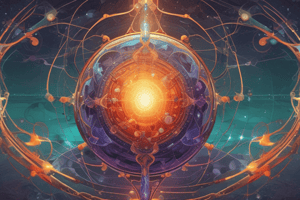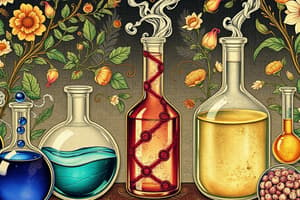Podcast
Questions and Answers
What is a solution?
What is a solution?
- A mixture where all components can be seen separately
- A mixture that separates into layers over time
- A homogeneous mixture where a solute is dissolved in a solvent (correct)
- A heterogeneous mixture of solid and liquid
Which of the following is an example of an insoluble substance?
Which of the following is an example of an insoluble substance?
- Rice grains (correct)
- Vinegar
- Salt
- Sugar
Which of the following factors does NOT affect solubility?
Which of the following factors does NOT affect solubility?
- Temperature of the solvent
- Stirring
- Color of the solute (correct)
- Size of the solute
In a salt solution, what is the role of water?
In a salt solution, what is the role of water?
What defines a substance as soluble?
What defines a substance as soluble?
What characterizes a homogeneous mixture?
What characterizes a homogeneous mixture?
Which of the following is an example of a heterogeneous mixture?
Which of the following is an example of a heterogeneous mixture?
What is a defining feature of heterogeneous mixtures?
What is a defining feature of heterogeneous mixtures?
Which of the following mixtures would be classified as homogeneous?
Which of the following mixtures would be classified as homogeneous?
Which mixture can be separated into its components most easily?
Which mixture can be separated into its components most easily?
What characterizes a diluted solution?
What characterizes a diluted solution?
Which of the following describes a concentrated solution?
Which of the following describes a concentrated solution?
What happens in a saturated solution?
What happens in a saturated solution?
Which scenario illustrates a saturated solution?
Which scenario illustrates a saturated solution?
How is the type of solution primarily determined?
How is the type of solution primarily determined?
What is an example of a liquid solution?
What is an example of a liquid solution?
Which of the following describes immiscible liquids?
Which of the following describes immiscible liquids?
Which of the following is a characteristic of gaseous solutions?
Which of the following is a characteristic of gaseous solutions?
What is a common use of sugar solutions?
What is a common use of sugar solutions?
Which of the following substances is an example of a solid solution?
Which of the following substances is an example of a solid solution?
Study Notes
Homogeneous and Heterogeneous Mixtures
- Homogeneous mixtures have substances evenly distributed, resulting in a uniform appearance.
- Examples include vinegar, soy sauce, and orange juice.
- Heterogeneous mixtures consist of unevenly distributed substances, lacking uniform composition.
- Components in heterogeneous mixtures are visible, such as in vegetable salad, cereal with milk, pizza, and mixtures like sand, water, and oil.
Types of Mixtures
- Daily life mixtures are categorized into solutions, suspensions, and colloids.
Solutions
- Solutions are homogeneous mixtures where one substance dissolves in another, typically a liquid.
- Salt solution serves as an example, with salt as the solute and water as the solvent.
- Sweet-and-sour sauce contains sugar and salt as solutes, and vinegar and water as solvents.
Solubility
- Solubility measures the maximum amount of solute that dissolves in a given solvent at a specific temperature.
- Soluble substances, like sugar and salt, dissolve easily, while insoluble substances do not, such as rice, corn, and pebbles.
- Factors affecting solubility include stirring, temperature, solute size, and the properties of solute and solvent.
Types of Solutions
- Solutions can be diluted, concentrated, or saturated based on solute quantity:
- Diluted solutions have a small amount of solute (e.g., powdered juice in water).
- Concentrated solutions contain a large amount of solute (e.g., three tablespoons of powdered juice in water).
- Saturated solutions occur when no more solute can dissolve, causing solid particles to settle.
Solutions by Phase
- Solutions can be liquid, gaseous, or solid.
Liquid Solutions
- Formed by dissolving solids, liquids, or gases in liquid solvents.
- Examples include syrup (sugar in water) and brine (table salt in water).
- Miscible liquids blend well, while immiscible liquids, like oil and water, do not mix.
Gaseous Solutions
- Carbonated water is a solution with dissolved carbon dioxide.
- Air represents a mixture including various gases like oxygen, nitrogen, and carbon dioxide.
Solid Solutions
- Examples include steel (carbon and iron) and brass (zinc and copper).
Uses of Solutions
- Salt and sugar solutions enhance food flavor.
- Liquid soaps dissolve grease and stains.
- Beverages like tea, coffee, and soft drinks are solutions.
- Medicines are often in solution form for easy internal use.
- Digestion transforms food into soluble forms for transport in the bloodstream.
- Industrial processes use solutions for manufacturing.
- Minerals in soil are absorbed by plants in solution.
Studying That Suits You
Use AI to generate personalized quizzes and flashcards to suit your learning preferences.
Description
Test your understanding of homogeneous and heterogeneous mixtures with this quiz. Explore the differences, examples, and characteristics that define each type of mixture. Perfect for chemistry students looking to reinforce their knowledge.




